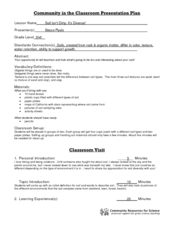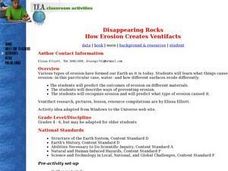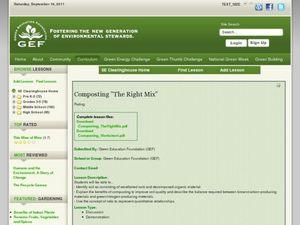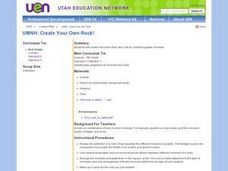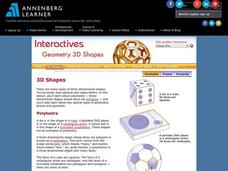Curated OER
Making Rocks
Learners use their imaginations in order to journey to the center of the earth to find different types of minerals. They create minerals using playdough and create scientific drawings of them. Finally, students create a map to locate the...
Curated OER
Soil Isn't Dirty; It's Diverse!
Second graders participate in a soil activity. In this soil lesson students complete a worksheet describing different soil types and the organic and inorganic things found in them.
Curated OER
Observing and Classifying Rocks
Fourth graders examine various types of rocks and record their properties. They collect rocks at home and bring them to school where they are mixed and distributed to groups of students. After writing their observations on...
Science Friday
Mineral Madness
Science does not need to be as hard as a rock. Pupils test 10 different minerals to determine their properties. The learners observe luster, streak, hardness, and fluorescence for each specimen. Afterwards, they compare and contrast the...
Science Matters
A Model of Plate Faults
The San Andreas fault is one of the longest fault zones in the world. In a series of 20 lessons, the fourth lesson has pupils use a paper model to recreate various types of plate faults. Each is held in position then drawn...
Curated OER
John Lennon
Here is a great example of the type of biographical presentation your class could create. They can view this informational biography of John Lennon to learn about a famous person or as inspiration for a research project. Each slide...
Curated OER
Engineering - Solid Rock to Building Block
Students role-play as engineers designing wedge tools. They devise methods for shaping quarry rocks into pyramid blocks. Following a teacher demonstration, they use materials such as soap, clay, and foam for blocks and wood, plastic,...
Curated OER
Disappearing Rocks
Students explore the causes of erosion and observe how different surfaces erode differently. They recognize erosion and predict what type of erosion caused it. In addition, they predict the outcomes of erosion on different materials.
Curated OER
The Japanese Garden
Students use the internet to gather information on the Japanese Gardens. They discuss topics with a horticulturist and build a replica of the gardens at their school. They work together to identify different types of plants.
Curated OER
Composting "The Right Mix"
Students investigate the correct mix of material types for compost. In this composting lesson plan, students explore the correct amounts of different types of materials to create a compost heap. Students then create a compost heap.
Curated OER
Bring A Rock
Middle schoolers investigate rocks and minerals. They collect a rock, describe it in writing, and in small groups divide their group of rocks into subgroups based on their team's classification.
Curated OER
Create Your Own Rock!
Fourth graders create and name their own rock by combining paper minerals. They define rock and mineral, examine samples of minerals, and using colored scrap paper, arrange and glue the pieces of paper to represent a new mineral.
Curated OER
Bridge Construction
Young scholars build a model of a bridge and test the amount of weight it support. They identify different types of bridges: suspension, arch, girder, truss, cantilever, cable-stayed and moveable.
Curated OER
Water: Naturally Cleaned
Students use stream trays covered in different types of rocks or soil to investigate infiltrates and runoff. In this water pollution activity, students work in groups with stream trays that have different substrates. They write a...
Curated OER
Coal Derivatives by Destructive Distillation
Chemists use the destructive distillation technique to produce three derivatives from a sample of bituminous coal. You will find background information, a materials list, procedures, and sample follow-up questions that you can use in...
Annenberg Foundation
Geometry 3D Shapes: 3D Shapes
Explore vocabulary related to three-dimensional shapes. An instructional website describes the characteristics of different geometric solids. Learners can use an interactive component to view nets, faces, vertices, and edges of common...
NOAA
Importance of Deep-Sea Ecosystems – Chemists with No Backbones
Marine invertebrates offer us many new options for developing pharmaceutical drugs, such as w-conotoxin MVIIA, which is extracted from the cone snail and is a potent painkiller. The lesson encourages scholars to research various types of...
Curated OER
Listen Up: Antigone Rising
Upper graders listen to and watch a documentary about an all female group Antigone Rising. They discuss how females are portrayed in the rock world, the type of music they play, their song lyrics, and what they note in the documentary....
Curated OER
Pushes and Pulls
Students recognize different types of movement and causes that my affect the movement. They know that pushes and pulls are types of forces.
Curated OER
Rockin' and Rollin'
Seventh graders, in groups, describe the three major types of rocks through either a song, skit, poem, etc. They present their work to the class during a "rock concert."
Curated OER
Coasts
Students explain the different types of marine coasts and where they are located in the United States and its territories. They explain and identify some of the life forms that inhabit different marine coastal regions.
Curated OER
Cell Study
Students (females) are introduced to the cell. They discuss what a cell is, and students define what a cell is. Students comprehend that all living things are made up of cells. They comprehend that life is defined as something that...
Curated OER
Feeling Hot, Hot, Hot!
Students study the different types of volcanoes and how they erupt. In this volcano lesson students identify where volcanoes are most prevalent and options for predicting eruptions.
Curated OER
Seismic Waves
In this seismic waves activity, student will read information about the different types of waves that occur during an earthquake: P (Primary) waves, S (Secondary) waves, and shear waves. Then students will complete 2 short answer questions.



